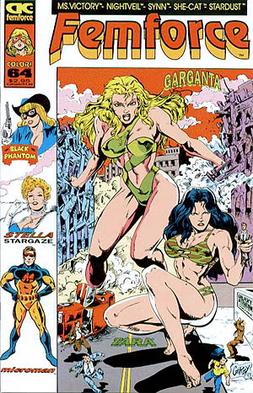
Femforce is a comic book published by AC Comics that began publication in 1985, detailing the adventures of the titular team: the "Federal Emergency Missions Force" or "Femforce", some of them original creations, while others originated in the 1940s and 1950s, lapsing into public domain by the time Femforce was published. The team are, as their name implies, all superheroines, and are the first and the longest running all-women 'super-team'. The series has passed 150 issues, a significant milestone for an independent comic book company. Writers on the book have included Bill Black, Stephanie Sanderson, Mark Heike, Paul Monsky, Enrico Teodorani and Francesca Paolucci. Artists on the book have included Bill Black, Stephanie Sanderson, Mark Heike, Brad Gorby, Jeff Austin, Dave Roberts and Rik Levins.
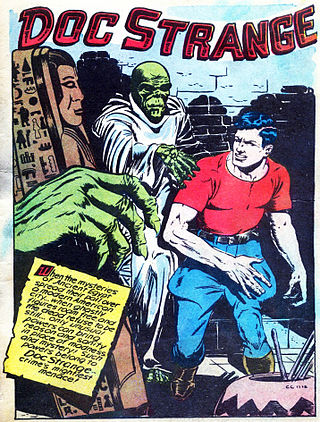
Doc Strange is a Golden Age comic book superhero who originally appeared in Thrilling Comics #1 in February 1940. The character continued in Thrilling Comics until issue #64. He also appeared in America's Best Comics #1-23 and 27.
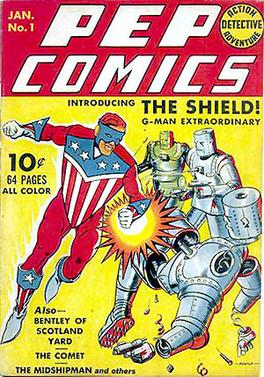
The Shield is the name of several superheroes created by MLJ. Appearing months before Captain America, the Shield has the distinction of being the first superhero with a costume based upon United States patriotic iconography. The character appeared in Pep Comics from issue #1 to #65.

Nick Fury's Howling Commandos was an American comic book series published by Marvel Comics. Running six issues before its cancellation and cover-dated December 2005 to May 2006, the series featured a fictional team set in the Marvel Universe, consisting of supernatural characters employed as a unit of the espionage agency S.H.I.E.L.D.

Blue Diamond is a fictional superhero appearing in American comic books published by Marvel Comics, debuting under the company's 1940s forerunner, Timely Comics. The character was created in 1941 by Ben Thompson, who also drew the first comic book adventures of Ka-Zar the Great and Citizen V for Timely, as well as the Masked Marvel for Centaur Publications and Dr. Frost for Prize Comics.

"Professor Supermind and Son" was a comic book feature that appeared in issues #60–71 of Dell Comics' Popular Comics. The strip was drawn by Maurice Kashuba.
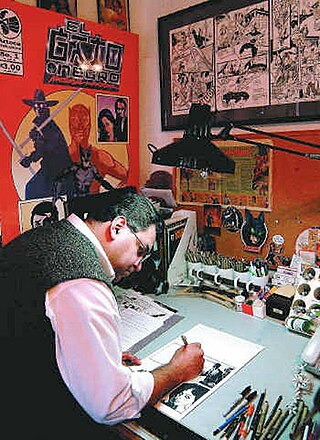
Richard Dominguez is an American comic book artist and freelance storyboard illustrator. Best known for creating the popular series El Gato Negro, Dominguez publishes his comics through his imprint and art studio, Azteca Productions. Dominguez also is well known for influencing other artists and creators in the pursuit of their own self-publishing ventures.>

El Gato Negro is the name of two fictional American comic book superheroes created by Richard Dominguez and featured in the Azteca Productions' Universe. Both characters made their first appearance in El Gato Negro #1.
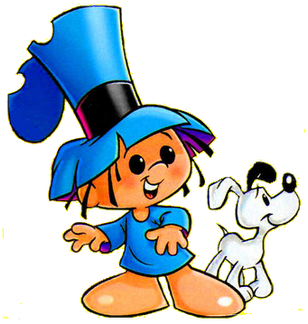
Hijitus is an Argentine comic superhero created by Manuel García Ferré. He made his debut in September 1955 in the comic strip The Adventures of Pi-Pío, published in Billiken magazine. In his debut he wear a bowler hat, but when it was republished in the Anteojito magazine, it appeared with a top hat, he was only a side character then, but after having some modifications became the protagonist of his own action comedy animated series The Adventures of Hijitus which was broadcast in Argentina between 1967 and 1974. Later it in the 1990s and in 2010-2012 was broadcast again through El Trece channel with a high audience rate. He is one of the best-known Argentine comic characters, along with Patoruzú, Mafalda, Clemente and Juan Salvo "Eternauta". The TV series is frequently re-transmitted on Argentinian television as many Argentinians perceive it as nostalgic.

Samson is a superhero who appeared in comic books published by Fox Feature Syndicate. He first appeared in Fantastic Comics #1. The writer was uncredited, but is believed to be Will Eisner; the artist was Alex Blum, using the pseudonym "Alex Boon".
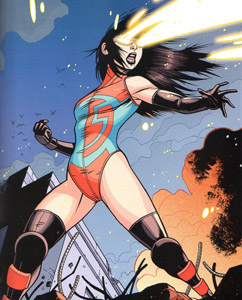
Bridget Flynn is a fictional comic book superheroine, a member of the superhero team Dynamo 5, which appears in the monthly series of the same name from Image Comics. Created by writer Jay Faerber and artist Mahmud A. Asrar, the character first appeared in Dynamo 5 #1.
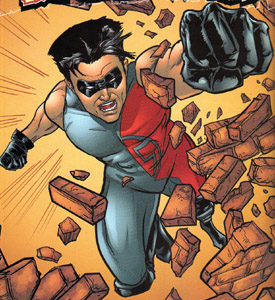
Hector Chang is a fictional comic book superhero, a member of the superhero team Dynamo 5, which appears in the series of the same name from Image Comics. Created by writer Jay Faerber and artist Mahmud A. Asrar, Visionary first appeared in Dynamo 5 #1.
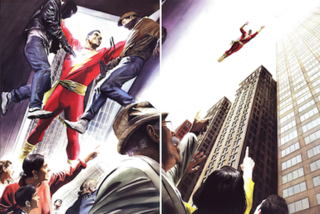
A superpower is a special or extraordinary superhuman ability that is greater than what is considered normal. Superpowers are typically displayed in science fiction and fantasy comic books, television programs, video games, and films as the key attribute of a superhero. The concept originated in American comic books and pulp magazines of the 1930s and 1940s, and has gradually worked its way into other genres and media.

Jackpot is the name of several superheroes appearing in American comic books published by Marvel Comics. The first incarnation of Jackpot, Sara Ehret, first appeared in Spider-Man: Swing Shift. The second incarnation, Alana Jobson, debuted in The Amazing Spider-Man #545.
Relámpago is the Spanish word for lightning.

Azteca Productions is an American comic book publisher and imprint founded by comics creator Richard Dominguez in 1993. The company's first publication was El Gato Negro #1 showcasing the debut of the eponymous character, in what is now considered the company's flagship series. Publications went on hiatus during the rise and fall of the speculative market in the late 1990s until Dominguez returned in 2004.

Pineapple Man is a fictional independent comic book superhero created by Sam Campos and published under the SoloGraphics imprint, formed both by himself and his wife Genesis. The character made his debut appearance in a two-part story arc titled Pineapple Man #0: The Hunt in 1994.

Francisco "Pancho" Guerrero, Jr., also known as El Gato Negro, is a fictional character and comic book superhero created by Richard Dominguez and published by Azteca Productions. The character made his first appearance in El Gato Negro #1.
Margarito C. Garza was an American judge and comic book enthusiast. He served as the 148th District Court Judge of Corpus Christi, Texas. for 3 terms in the 1980s to the 1990s and served two terms as Judge of the Nueces County Court at Law from 1972-1976 .He also served as Assistant District Attorney in Corpus Christi in the late 1960s. Garza was the first Mexican American to be elected to a judgeship in Nueces County. He was also notable for creating the first Mexican-American comic book hero, Relampago, in 1977 and was a pioneer in the nascent industry of comic retailers. Garza died in 1995 after a lifetime of public service to his community.

Jupiter's Legacy is an American superhero comic book series, first published in 2013, written by Mark Millar, drawn by Frank Quitely, colored and lettered by Peter Doherty and published by Image Comics. Published as a series of eponymous limited series and interstitial prequel miniseries, it is to date the longest series that Millar had published as part of his Millarworld line of creator-owned comics, spanning an issue run three times as long as his then-most recent series, Super Crooks and Nemesis. It was also the first collaboration between Millar and Quitely since their work on The Authority in 2001, and Quitely's first long-form work with a writer other than Grant Morrison.
















